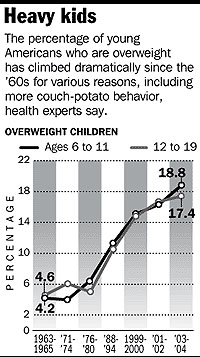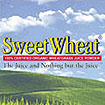Overweight kids: Schools take action
By
Amanda
Paulson | Staff writer of The Christian
Science Monitor
Photos By Stephen J. Carrera | Special to The
Christian Science Monitor
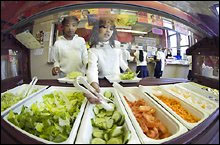 |
CUKES,
NOT CHIPS: Second-grader Andrea Nuñez
gets a salad for lunch at Chicago's Nettelhorst
Elementary, which put in a salad bar and
pulled snack foods to combat obesity. |
CHICAGO
- Erykah Martin's lunch is a model of nutrition:
a lettuce and carrot salad, an apple, a granola
bar, and (the one kid-like concession) chocolate
milk.
Salad
is the second-grader's favorite lunch item, she
says, "'cause all the things you put in it
is healthy and good." She wrinkles her nose
and shakes her black braids at the idea of hot
dogs, the cafeteria's hot lunch option that day.The
salad bar at Chicago's Nettelhorst Elementary
School, where Erykah goes, is one way the school
is promoting healthier choices for students. It
also teaches nutrition, has an after-school cooking
program, has reinstituted recess, and has dance
and physical education classes - the sorts of
programs needed at far more schools, children's
health advocates say, given the rise in childhood
obesity.
The trends can seem alarming - one recent study
showed that 17 percent of children and adolescents
were overweight in 2004, up from 14 percent just
five years earlier. But more and more, schools
are starting to address the problem.
By
this summer, they must meet a federal mandate
for a comprehensive wellness plan. Recently introduced
federal legislation would require new minimum
nutrition standards for school lunches. Numerous
states are passing laws aimed at better food and
more physical activity for students. A few individual
schools, like Nettelhorst, are also taking the
initiative.
"I'm
very encouraged by what is occurring in schools,"
says Kelly Brownell, director of the Rudd Center
for Food Policy and Obesity at Yale University.
"One can just see the landscape changing....
At the moment, it's still a minority of schools,
but the number is growing and the state legislatures
are getting involved in requiring schools to change."
The
problem, he and others agree, is critical. One
recent New York study showed that 1 in 4 kids
in the city's Head Start program was obese by
the age of 2, and 40 percent of the Head Start
kids were either obese or overweight. The Centers
for Disease Control and Prevention doesn't have
an "obese" designation for children.
But its National Health and Nutrition Examination
Survey - considered the gold standard of weight
data because it uses actual measures instead of
self-reporting - showed that 17 percent of children
between ages 2 and 19 were overweight in 2004.
Another 17 percent were at risk of becoming so.
Studies
show that overweight children are highly likely
to become obese adults, who have an elevated risk
of many health problems. And America's growing
obesity rate is a prime reason for rapidly rising
healthcare costs, health experts say.
Story continues below
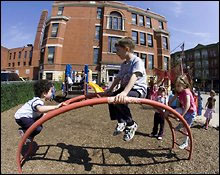 |
MORE
PLAY: This Chicago elementary school restored
recess to give students more physical activity.
Only 6 percent of the city's schools offer
20 minutes of recess. |
Legislators
focus on schools
Schools have become the major legislative target
for obvious reasons: Kids eat many meals there
- often breakfast and lunch - and policy can regulate
schools in a way that's impossible with families.
"Schools alone didn't cause the problem,
and schools alone can't solve the problem, but
we'd be hard-pressed to solve it without schools,"
says Howell Wechsler, director of the Division
of Adolescent and School Health at the Centers
for Disease Control.
A
few reform advocates see particular promise in
the wellness policies that all schools must have
in place by the coming school year. "It really
gives us an opportunity to have this discussion
in a way that can get systemwide changes,"
says Alicia Moag-Stahlberg, director of Action
for Healthy Kids, a national group that works
with schools and is helping many create their
wellness policies. "And kids have to be part
of it, too. If you make changes to the school
meal line without kids' involvement, you may just
encourage more bootlegging out of the locker."
The
reasons for the obesity problem are varied: bigger
portion sizes, kids who spend more time in front
of TVs and video games, neighborhoods that aren't
safe enough for outdoor play or walking or biking
to school.
And experts say that school-nutrition guidelines
are outdated. For example: jelly beans, lollipops,
and breath mints are not allowed, but donuts,
French fries, and soda are. Even more troubling
is the food not sold in cafeterias.
"There
is junk food for sale in just about every school
in America," says Allison Dobson, a spokeswoman
for Sen. Tom Harkin (D) of Iowa, who is sponsoring
a bipartisan bill to change the standards and
make them apply to all food in schools, including
that in vending machines. "This is a time
when we should be molding our kids' habits.
Critics
of such bills - primarily the snack-food industry,
but also some schools worried about losing revenue
- often say kids won't eat healthier options.
|
| SOURCE:
DEPARTMENT OF HEALTH AND HUMAN SERVICES;
AP |
"We feel that teaching kids to lead a balanced,
healthy lifestyle and make smart choices is more
important than restricting one category of food,"
says Jennifer Phillips, a spokesperson for the
American Beverage Association. She notes that
the ABA has adopted a voluntary policy that limits
high school vending-machine options to 50 percent
soft drinks, and supplies elementary schools only
with water and 100 percent juice. "We think
it should be a balance ... and more about teaching
children about nutrition and exercise."
But
all that's needed may be a little creativity,
says Christina Paxson, a Princeton University
professor of public affairs and editor of a recent
report on childhood obesity. Successful programs
"engage kids in learning about healthy food,
usually in very hands-on ways. They get them to
help prepare the food instead of just lecturing
them, they get them engaged in physical activity
in fun ways, sometimes in unconventional nongym-class
ways."
Kids
pick salads, after a little teaching
That sort of engagement has worked at Nettelhorst,
which was part of a pilot project that put salad
bars in three Chicago elementary schools. A study
of the project showed that without any nutrition
education, few kids chose the salads; with education,
the number doubled. On some days, nearly a third
of Nettelhorst students choose salad. No junk
food is available.
Susan
Kurland, Nettelhorst's principal, also made the
decision to bring back recess - a rarity in Chicago,
where a recent survey showed just 6 percent of
elementary schools have a recess of at least 20
minutes. "There isn't anything happening
here that can't happen at any other school,"
she adds. "Somewhere along the way we lost
the idea that school is where you teach kids how
to live life."
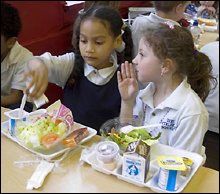 |
SALAD
DAYS: First-graders Camille Miles (left)
and Alexia Kollar take advantage of Nettlehorst
Elementary's salad bar in Chicago. |
Support the Monitor's independent journalism:
Make
a tax-deductible donation today.
Related
Stories
At
snack time, think 'outside the bag'
02/22/06
Snickers
for lunch? Now mom can eye student purchases.
11/22/05
California
says 'no' to junk-food sales in schools
09/06/05





